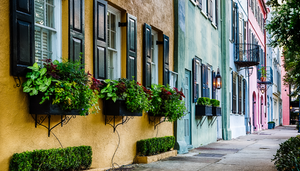As the major spring holidays—Ramadan, Holi, Easter, and Passover—take precedence in the world around us, it can be a challenging time for queer people. After all, the world's monotheistic religions have not always been the most inviting to our community. Whether it's a history of anti-LGBTQ+ rhetoric or even the growing tide of secularism many queer people embrace, we just don't feel at home in traditional faith settings.
I was raised in a typical Italian-American home where Catholicism shadowed everyday life. As a kid, I loved connecting with saints and angels and believing that a steady, focused prayer could bring about a miracle. As I matured into young adulthood, emotionally and physically, I came up against complex facts that made me rethink my relationship with Catholicism. As a gay man, no matter how I looked at it, I would always be seen as a sinner.
I yearned for a deeper spiritual connection but was taught that God disapproved of my lifestyle.
At the same time, I was also raised in a home where folk magic was practiced, allowing me to see there were other paths I could turn to. In college, an elder passed down a specific prayer to me. When she recited it, she uttered "Ave Diana" instead of "Ave Maria." In that moment, I was at once awestruck and profoundly transformed. Here was a devout Catholic invoking the Roman Goddess of the hunt, fertility, and the moon instead of the Virgin Mary, one of Catholicism's most beloved figures!
I looked at her with curiosity and shock and asked her what she had said. She smiled, waved her hand dismissively, and didn't answer. I asked her again, urging her to repeat her words. A knowing smile creased her lips, and she stared unerringly into my eyes. "You heard me," she said. "Now stai zitto!" Translation: Shut up!
At that moment, a switch flipped, a light blinked, and a gateway opened. All the years of literature and history classes—of reading about the mythic gods and goddesses of antiquity—fell into place. I dove into the world of deities, first in the Roman and Greek traditions, then expanded to the vast pantheon of other cultures and religions.
This also coincided with the deepening of my magical education and my discovery of a vast syncretism of deities within folk magic practices, my family's practices, and other traditions. These deities celebrated every aspect of my identity. They created positive spiritual associations with sex, love, nature, and other concepts that were long dismissed by traditional religious paths.
In my learning, I began to accept and harness the power of integrating deities into my spiritual practice. The results were profoundly empowering and created the foundation for a spirituality I never dreamed existed.
As we mark upcoming holidays like Beltane, Summer Solstice, and Lughnasa, it's time for queer people to get their deity on and connect with a divine source that can hold the fullness of who we are and who we want to be. One of the most inspiring aspects of deity worship is that they run the gamut of genders and identities and fit perfectly into those areas of life we wish to change—from love and career to home, family, and self-empowerment.
For beginners or those returning to the spiritual fold after an extended absence, this is an opportunity to get to know a deity (or a few) and how they resonate with you. Ask yourself which deity or deities stand out for you? What feelings does a particular deity evoke? What do you most want to manifest in partnership with this divine being?
This is the beginning of a new spiritual journey. A way to enhance a part of our queer identity that often gets pushed aside to distance ourselves from the past pain of religious experiences or in our attempts to rationalize the extraordinary. Leave it all behind and embrace a new paradigm where you have the divine—in whatever form your deity takes—on your side.
Saint Joan of Arc

The golden statue of Saint Joan of Arc on the Rue de Rivoli in Paris, France
Shutterstock
She is known in history as the French peasant girl who led an army to victory, encouraged by the voices and visions of Saints Michael, Catherine, and Margaret. But when we look more deeply—and honestly—at Saint Joan, we see a symbol not only of rebellion and determination but one of gender nonconformity. At a time when women were supposed to remain obedient, if not altogether silent, to authority, Joan clothed herself in full military armor, which was restricted to only to men. Today, she is a patron to those who cross-dress, those who identify as nonbinary or asexual, and the transgendered in general. She is perhaps the ultimate symbol of resistance because she refused to renounce what she knew was her true identity, making her a powerful queer icon.
Apollo

Apollo Belvedere statue in Pushkin Museum
Gilmanshin/Shutterstock.com
A deity of empowerment and knowledge, Apollo has long been connected to the spiritual journey of gay men. Among Apollo's lovers were Adonis and Hymenaois, but Hyacinthus is perhaps the best-known as the object of Apollo's affection. Hyacinthus was a Spartan prince who was celebrated for his physical beauty, a beauty that quickly caught Apollo's eye. According to myth, the relationship between Apollo and Hyacinthus was tender and warm. Apollo taught Hyacinthus vital skills like archery and prophecy. Apollo also nurtured Hyacinthus. Theirs is an early example of same-sex love and a reminder that same-sex love was not merely tolerated but celebrated. In art and literature, numerous depictions of Apollo and Hyacinthus describe their intimacy and the depth of their love.
Ishtar

Terracotta relief with depiction of a one winged goddess, standing on two ibexes
PHAS/Universal Images Group via Getty Images
Also known as Inanna in some interpretations of myth and history, the Mesopotamian goddess Ishtar is often celebrated as a queer deity of empowerment for her link to gender fluidity and, in some stories and myths, nonbinary identity. According to scholar Rivkah Harris, Ishtar "confounded and confused narrative categories and boundaries" and was both "male and female," possessing masculine and feminine traits. She is also known as the "bearded goddess" of courage. Ishtar is also a goddess of love and fertility and, in some accounts, is noted for her voracious sexual appetite. Her physical characteristics reveal multiple genders.
Santa Muerte

A devotee holds a figurine of Santa Muerte (Holy Death) as part of the Dia de los Muertos (Day of the Dead) celebrations at the Tepito district
Jam Media/LatinContent via Getty Images
The cult of Santa Muerte has grown exponentially over the past several decades and is now considered a global movement—and for good reason. The "skeleton saint" represents much more than just death. She is a folk saint of the marginalized, offering protection and empowerment to the queer community. Those once viewed or treated as outcasts will find comfort under Santa Muerte's motherly mantle. She is an example that everyone is equal in death, and so should they be equal in life. The queer identity occupies a liminal space, and so does Santa Muerte. She is fierce and bold, nurturing and non-judgmental. Santa Muerte reminds us that we find the healing power of self-love and the strength to conquer our challenges in the depths of darkness.
Bahuchara Mata

The file picture dated 08 May 2014 shows Sonal Maasi (R), a transsexual, blessing the Hindu V.N. Balakrishna while being watched by Gita Maasi (C) and Kanta Maasi (L) in Becharaji, India
Doreen Fiedler/picture alliance via Getty Images
In India, Bahuchara Mata is a goddess whose myth has several iterations. Primarily venerated by the hijra community—comprised of transgender, intersex, and people who identify as a third gender—this Hindu goddess embodies justice, strength, and courage, and grants protection to her devotees. In one story, Bahuchara and her sisters were attacked by a thief while traveling; after cursing the thief with impotence, Bahuchara severed her breasts from her body, doing away with her femininity. In another, it is said that she appeared to a noble prince and instructed him to sever his genitals and wear women's clothing to worship her. Nearly all of the stories about her involve a gender change. Today, the hijras believe that being blessed by Bahuchara Mata bestows them with the power to bless and curse others.
Cybele

Fountain of Cybele (Spanish: Fuente de Cibeles) bronze replica at the roundabout in Plaza Villa de Madrid in Roma neighborhood with jacaranda trees blooming
Santiago Castillo Chomel/Shutterstock.com
A Phrygian goddess, Cybele is yet another example that transgender people have been with us for a long time. She was first worshipped in ancient Anatolia, and by 500 BCE, she was revered in Greece. Her cult eventually made its way to ancient Rome, where her priests, known as the Galli, are believed to have been men who castrated themselves and wore women's attire to venerate her. In one myth, Cybele is an intersex goddess who brings fear to the other gods, who severed her penis. She took a young lover, Attis, who cheated on her and, consumed with guilt, castrated himself. Revered as Mother of the Gods, Cybele is also associated with motherhood, fertility, and nature of the wild variety.
Hermaphroditus

Sleeping Hermaphroditus in the National Roman Museum in Rome
Takashi Images / Shutterstock.com
In Greek mythology, Hermaphroditus is the child of Aphrodite and Hermes. Born with both male and female genitalia, he was known for his extreme beauty. In Greco-Roman art, he is often depicted as a female figure with male genitals. Hermaphroditus was venerated as a god of marriage and described as one of the winged "love-gods" known as Erotes. A popular myth states that Hermaphroditus was spotted by a nymph, who became so enamored with him that she begged the gods to remain in his presence forever. In answer to her prayer, the gods merged their forms into one. Long associated with intersex people and a patron to those who embody effeminate traits or identity, Hermaphroditus symbolizes the sacred unity of male and female.
Antonio Pagliarulois the author of The Evil Eye: The History, Mystery and Magic of the Quiet Curse and the forthcoming The Queer Saints: A Radical Guide to Magic, Miracles and Modern Intercession.
Voices is dedicated to featuring a wide range of inspiring personal stories and impactful opinions from the LGBTQ+ community and its allies. Visit advocate.com/submit to learn more about submission guidelines. We welcome your thoughts and feedback on any of our stories. Email us at voices@equalpride.com. Views expressed in Voices stories are those of the guest writers, columnists and editors, and do not directly represent the views of The Advocate or our parent company, equalpride.




















































































Fans thirsting over Chris Colfer's sexy new muscles for Coachella